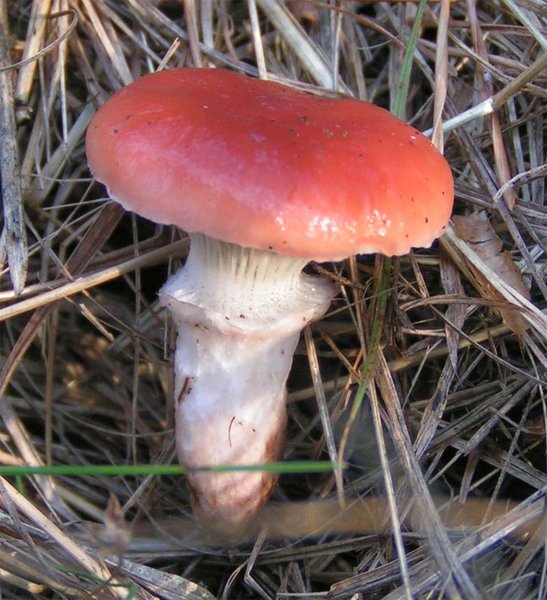- Gomphidius roseus
Taxobox
name = "Gomphidius roseus"

regnum =Fungi
divisio =Basidiomycota
classis =Agaricomycetes
ordo =Boletales
familia =Gomphidiaceae
genus = "Gomphidius"
species =
species = "G. roseus"
binomial = "Gomphidius roseus"
binomial_authority = (Pers.) Roussel (1898)mycomorphbox
name = Gomphidius roseus
whichGills = decurrent
capShape = flat
capShape2= convex
hymeniumType=gills
stipeCharacter=ring
ecologicalType=mycorrhizal
sporePrintColor=blackish-brown
howEdible=edible"Gomphidius roseus", commonly known as the rosy spike-cap or pink gomphidius, is a
gilled mushroom found inEurope . Although it has gills, it is a member of the orderBoletales , along with the boletes. It is a coral pink-capped mushroom which appears in pine forests in autumn, always near the related mushroom "Suillus bovinus ", on which it appears to be parasitic.Taxonomy
"Gomphidius roseus" was initially described by Swedish mycologist
Elias Magnus Fries as "Agaricus glutinosus ß roseus" in 1821, [la iconcite book |title=Systema mycologicum, sistens fungorum ordines, genera et species huc usque cognitas [Taxonomical System for Mycology, consisting of an ordering of the fungi, genera and species, as currently understood] , Vol. 1 |last=Fries |first=Elias Magnus |authorlink=Elias Magnus Fries|year=1821 |publisher= |location= |pages=p. 315] before he elevated it to species status and gave its current genus and binomial name in 1838. The genus name is derived from the Greek 'γομφος' "gomphos" meaning "plug" or "large wedge-shaped nail". [ cite book|author=Liddell HJ, Scott R|year=1980|title=Greek-English Lexicon, Abridged Edition |publisher=Oxford University Press, Oxford, UK|id=ISBN 0-19-910207-4] The specific epithet "roseus" is theLatin adjective "pink". [cite book|author = Simpson DP| title = Cassell's Latin Dictionary | publisher = Cassell Ltd.| date = 1979|edition = 5|location = London|pages = 883| isbn=0-304-52257-0]Description
The mushroom has a coral-pink cap up to 5 cm (2 in) in diameter, though sometimes larger, which is initially convex and later flattening and becoming a more brick colour with maturity. Often slimy or sticky as with other members of the genus, its cap lacks the blackish markings of the related "G. glutinosus".cite book | author = Nilson S & Persson O | year = 1977 | title = Fungi of Northern Europe 1: Larger Fungi (Excluding Gill-Fungi) | publisher = Penguin|isbn=0-14-063005-8|pages=p. 112] The stipe is 2.5–4.5 cm (1-1.6 in) high and 0.4–1 cm wide and bears an indistinct ring. It is white with a pinkish or wine-coloured tint and often flushed yellow at the base. The whitish flesh may also be tinged pink and has little taste or smell. The decurrent gills are grey, and the
spore print is brownish-black.cite book | author = Roger Phillips | year = 2006 | title = Mushrooms | publisher = Pan MacMillan | isbn = 0-330-44237-6|pages=pp. 270-71]Distribution and habitat
An uncommon fungus, "Gomphidius roseus" is found in Europe, but not in
North America . A similar pinkish species, "G. subroseus" occurs in North America.cite book |author=David Arora |year=1986 |title=Mushrooms Demystified |publisher=Ten Speed Press |isbn=0-89815-169-4|pages=p. 483] It is found in pine woods, particularly "Pinus sylvestris ", associated with "Suillus bovinus ", and is often hidden in undergrowth.cite book | last = Haas |first=Hans | year = 1969 | title = The Young Specialist looks at Fungi |pages=p. 52| publisher = Burke | isbn= 0-222-79409-7] Fruiting bodies sprout in the autumn.Ecology
Like other members of the family Gomphidiaceae, "Gomphidius roseus" has been thought to be
ectomycorrhizal , forming symbiotic relationship with their host trees. However, there is now evidence that many (and perhaps all) species in this group areparasitic upon ectomycorrhizalboletes , in relationships that are often highly species-specific, in this case "Suillus bovinus ".Olsson PA, et al. (2000). Molecular andanatomical evidence for a three-way association between "Pinus sylvestris" and the ectomycorrhizal fungi "Suillus bovinus" and "Gomphidius roseus". Mycological Research 104:1372–1378. ( [http://journals.cambridge.org/action/displayAbstract?fromPage=online&aid=64133 abstract] )]Edibility
"Gomphidius roseus" is not known to be toxic but is reported to be of poor quality and hence not recommended for picking.cite book |title=The Great Encyclopedia of Mushrooms |last=Lamaison |first=Jean-Louis |coauthors=Polese, Jean-Marie |year=2005 |publisher=Könemann |isbn=3-8331-1239-5|pages=p. 34]
References
Wikimedia Foundation. 2010.
